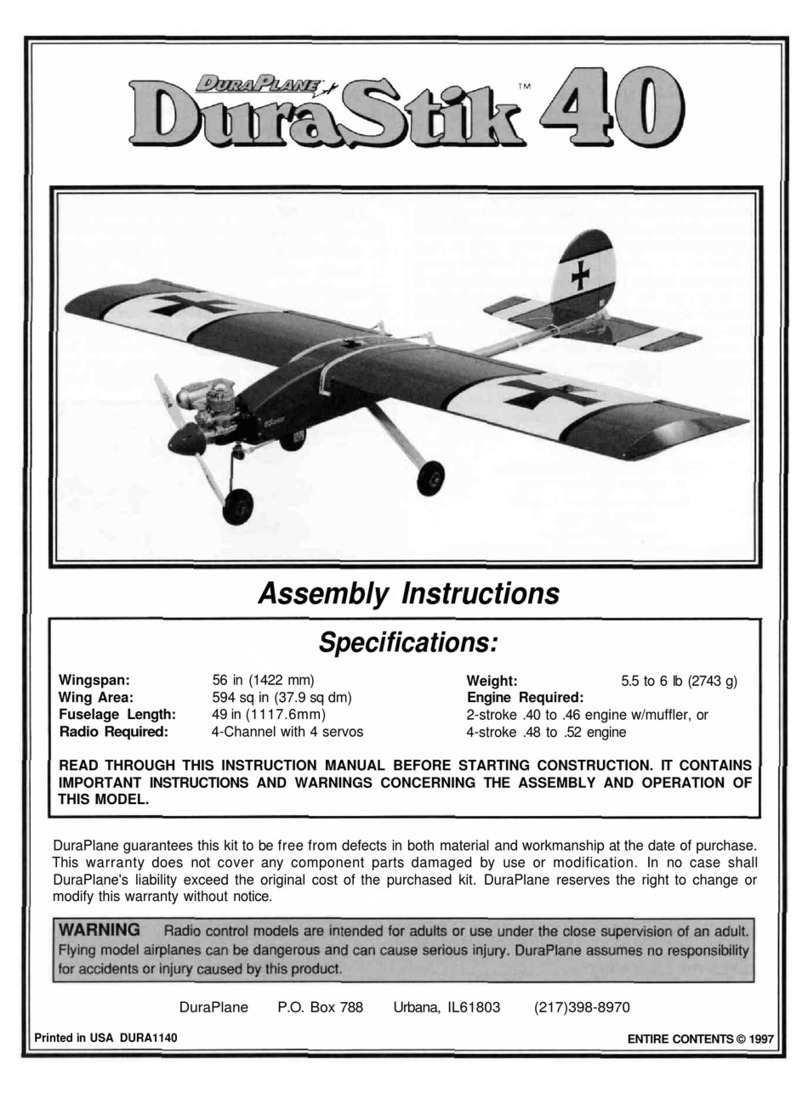The Trainer 40 is a great “dual purpose” model because it's
extra durable and simple to build for a beginner, and it builds
fast so experienced modelers can quickly get something in
the air if their primary model is out of commission. After you
move on to a fully aerobatic sport model, or get your best
model back into the air, the trusty Trainer 40 will still be
waiting in the wings for you to take it out and get in a few
relaxing flights. The “low risk” factor of the inexpensive, quick
building DuraPlane series makes them great test beds for
new radio equipment or breaking in new engines. Besides all
that, the Trainer 40 flies great and we're sure you'll enjoy lots
of smooth takeoffs and landings!
If this is your first model, the best way to learn to fly R/C is
to join a flying club. The Academy of Model Aeronautics is
the national organization that charters model clubs,
sanctions competitions and insures flying fields throughout
the United States. We urge you to join the AMA because
membership will bring you flying insurance, a subscription
to Model Aviation magazine and many other benefits. The
AMA will gladly send you membership information and lists
of AMA-chartered clubs in your area where you can seek
the help of experienced modelers.
Academy of Model Aeronautics
5151 East Memorial Drive
Muncie, Indiana 47302-9252
(800) 435-9262
FAX (317) 741-0057
Your hobby shop is also an invaluable place for service,
parts and information that you require. We urge you to
patronize your local hobby dealer – he’s there to help you
enjoy your hobby. Finally, if you have any questions or
comments about your DuraPlane, please write or call us at:
DuraPlane
3002 N. Apollo Dr. Ste. 1
Champaign, IL 61822
Telephone: (217) 398-8970, Ext. 5
Fax: (217) 398-7721
DuraPlane guarantees this kit to be free from defects in
both material and workmanship at the date of purchase.
This warranty does not cover any component parts
damaged by use or modification. In no case shall
DuraPlane’s liability exceed the original cost of the
purchased kit. DuraPlane reserves the right to change or
modify this warranty without notice.
This instruction manual provides step-by-step instructions
for assembling the Trainer 40 kit. Assembly of the Trainer
40 consists of eight major steps and must be completed in
the following order:
BUILD THE TAIL FEATHERS.......................Page 3
ASSEMBLE THE FUSELAGE.......................Page 5
RADIO INSTALLATION.................................Page 7
BUILD THE WING.........................................Page 9
COVER THE WING & TAIL SURFACES......Page 11
FINAL ASSEMBLY........................................Page 12
BALANCE THE MODEL................................Page 13
FINAL HOOKUPS & CHECKS......................Page 14
FLYING..........................................................Page 15
To assemble the Trainer 40, you need the following tools:
❏Flat blade and phillips screwdrivers
❏Small pliers (needle nose)
❏Hobby knife with #11 blades
❏Electric drill
❏Drill bits: 1/16", 7/64", 1/8", 5/32", #18 (or 11/64")
❏Hobby covering iron w/Hot Sock™– optional
(TOPR2175)
❏Sandpaper assortment and sanding block
❏Ruler & felt-tip pen
❏Masking tape
In addition to the parts included with the Trainer 40 kit, you
need the following accessories (we have had good success
using Great Planes®brand Adhesives and Accessory Items):
❏4-channel radio w/4 servos
❏.40-.46 2-stroke or .48 - .51 4-stroke engine w/muffler
❏Propellers (see engine instructions for size)
❏Top Flite®EconoKote®film - (1) roll
❏6-minute epoxy – (GPMR6045)
❏1 oz. thin CA – (GPMR6002)
❏Aliphatic resin (white glue) – optional (GPMR6160)
❏#6 x 3/4" engine mounting screws – (4) (GPMQ3030)
❏2-1/4" spinner (GPMQ4515)
❏8 oz. fuel tank – (GPMQ4103)
❏12" medium silicone fuel tubing – (GPMQ4131)
❏#64 rubber bands – (HCAQ2020)
❏5/32" wheel collars – (2) (GPMQ4306)
❏1/4" foam rubber – (HCAQ1000)
❏2-1/2" wheels – (3) (GPMQ4223)
❏3/4" wide fiberglass reinforced “strapping” tape
❏1/2" double-sided foam mounting tape (GPMQ4440)
❏1/16" x 5/16" wing seating foam tape (GPMQ4422)
❏Loctite®thread lock
Refer to the Parts List for a description of the parts and
hardware included with the Trainer 40 kit.
Accessories & Additional Items
Suggested Tools
Table of Contents
WARNING
Radio control models are intended for adults or use
under the close supervision of an adult. Flying model
airplanes can be dangerous and can cause serious
injury. DuraPlane assumes no responsibility for accidents
or injury caused by this product.
Introduction
2





























